ASUS E35M1-M Pro Review - Anyone For Fusion?
by Brendan van Varik on October 25, 2011 5:00 AM EST- Posted in
- Asus
- Motherboards
- Fusion
- E-350
LAN Speed Test
LAN Speed Test is a freeware program designed for testing the network connection between two PCs on a home network. The speed of the transfer is limited by the lowest common denominator on the network, so if you have gigabit Ethernet capable computers but a 100 Mbit capable router, you are limited to 100 Mbit transfer. Note that this is really a formality – if a network port is rated at 1 Gbps, then chances are that it will hit at least 90+% of this value. The main test here is CPU usage, and how much is offloaded by the controller. For this test, we use LAN Speed Test to transfer a 1000 MB file across a home network with a 1000 Mbps lowest common speed to the same machine each time, in a read/write scenario.
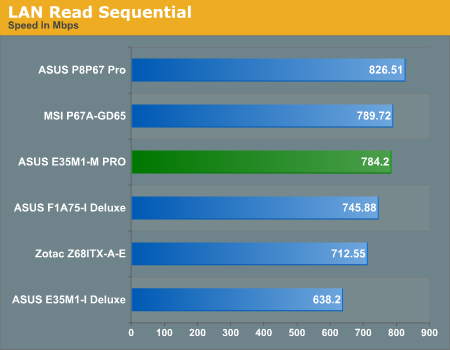
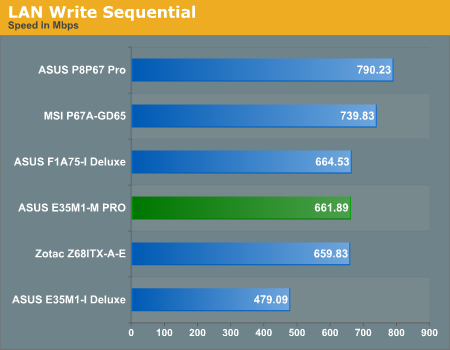
As we only have two results on the A50M platform which were tested under a 1 Gbps environment, I have decided to compare it to a few other platforms too. LAN throughput should be down to the onboard chip and therefore it has been compared to these platforms. Judging by the read and write speeds, the E35M1-M Pro does well for itself and is above average in the read tests but falls just under the average marker with the write tests.
USB Speed
For this benchmark, we run CrystalDiskMark to determine the ideal sequential read and write speeds for the USB port using our 64GB Patriot SuperSpeed USB 3.0 drive. Then we transfer a set size of files from the SSD to the USB drive, and monitor the time taken to transfer. The files transferred are a 1.52 GB set of 2867 files across 320 folders – 95% of these files are small typical website files, and the rest (90% of the size) are the videos used in the Sorenson Squeeze test.

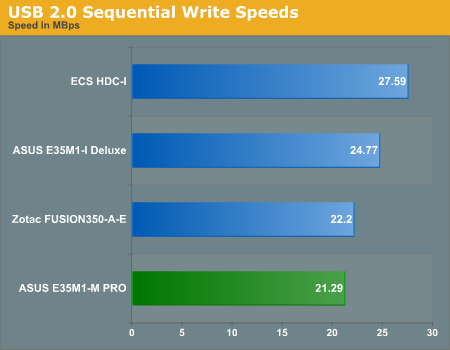
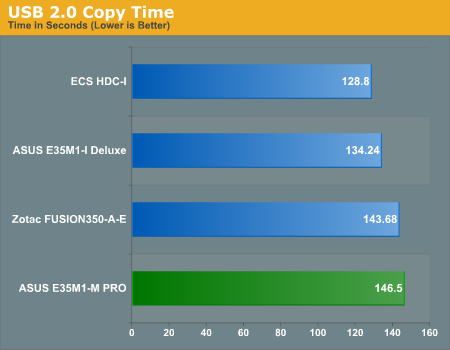
The USB 2.0 read speeds are above average out of the four boards but the writes on the other hand come in at bottom place. The reason for this is unknown.
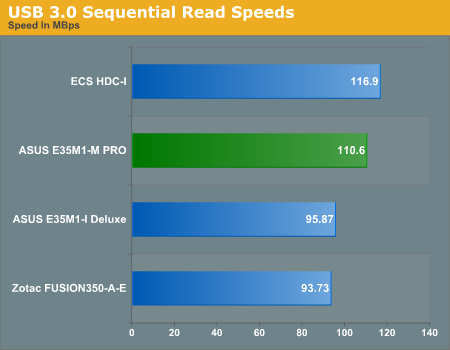

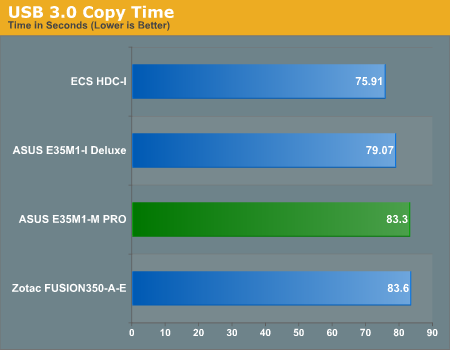
Write speeds on the USB 3.0 side of things are much better than the USB 2.0 results and the read speeds are above average here as well.
SATA Testing
We also use CrystalDiskMark for SATA port testing. The operating system is installed on the OCZ Vertex 3 240GB SSD, which is rated at up to 550 MB/s read and up to 520 MB/s write, and the sequential test is run at the 5 x 1000 MB level on a separate clean partition. This test probes the efficiency of the data delivery system between the chipset and the drive, or in the case of additional SATA ports provided by a third party controller, the efficiency between the controller, the chipset and the drive.


In the Vertex 3 testing the board got the fastest read speeds for A50M but the write speeds were below average. It is debatable whether a user would notice this is regular usage for this board, however.
DPC Latency
Deferred Procedure Call latency is a way in which Windows handles interrupt servicing. In order to wait for a processor to acknowledge the request, the system will queue all interrupt requests by priority. Critical interrupts will be handled as soon as possible, whereas lesser priority requests, such as audio, will be further down the line. So if the audio device requires data, it will have to wait until the request is processed before the buffer is filled. If the device drivers of higher priority components in a system are poorly implemented, this can cause delays in request scheduling and process time, resulting in an empty audio buffer – this leads to characteristic audible pauses, pops and clicks. Having a bigger buffer and correctly implemented system drivers obviously helps in this regard. The DPC latency checker measures how much time is processing DPCs from driver invocation – the lower the value will result in better audio transfer at smaller buffer sizes. Results are measured in microseconds and taken as the peak latency while cycling through a series of short HD videos - under 500 microseconds usually gets the green light, but the lower the better.

The E35M1-M PRO currently holds the lowest DPC Latency score in our records for the A50M platform.










66 Comments
View All Comments
mino - Wednesday, October 26, 2011 - link
IF not in a hurry, you better wait for a dual-core E2-series Llano.UrQuan3 - Wednesday, November 9, 2011 - link
I wish I had tested Netflix. 1080p youtube and 720p crunchyroll play fine, but flash has hardware acceleration on the E-350.Since I've gotten several 'free' Nexflix offers, maybe I should test it.
jacob733 - Tuesday, October 25, 2011 - link
What about the other SATA channels? It's nice to see throughput with a single SSD on a single channel, but all sorts of other effects come into play if you load all channels at once. For example my H55 board can be saturated even by LP class magnetic HDDs if I load all 6 channels due to channel sharing of some kind. Would be nice to know as apart from HTPC then E35M1-M Pro also looks perfect for homebrew NAS.firsthour - Tuesday, October 25, 2011 - link
Anyone have any experience running a FreeNAS box off this? I like the idea of the low power along with 5+1 SATA. Max 8GB memory is my only concern that I can think of, considering how hungry ZFS is.Anything else I should be concerned about? Is it worth waiting for an E-450 release?
mino - Wednesday, October 26, 2011 - link
AM3+ along with X2 240e is a far better choice for FreeNAS or simmilar- ECC
- excellent FullATX mobos with a bunch of slots for RAID/NIC's
fubird - Tuesday, October 25, 2011 - link
can I use i3-2100T and thermalright HR-02 to build a fanless system? Since I need 2 HDMI port and and the trend is lossless music file is becoming larger and larger, I don't think APU can handle that for a long run. That's why I prefer SB, but 0dB noise is a must.frozentundra123456 - Tuesday, October 25, 2011 - link
Why not test some older or less demanding games instead of Metro 2033 and Dirt?Both these games are clearly unplayable on this platform, so does a frame per second or two really make any difference?
Maybe try Sims 3, or Half Life 2, or KOTOR or Mass Effect, WoW or something. I cant think of any more specific games that might be actually playable, but I am sure there are a lot of games from the 2005 or so era that might still be fun and actually playable on this system.
Fradelius - Tuesday, October 25, 2011 - link
totally agree, testing crysis on this is not a wise ideawow on the other side.. works!
silverblue - Wednesday, October 26, 2011 - link
http://www.anandtech.com/show/4218/amds-brazo-e350...E-450 would mean a small improvement though not necessarily anything really measurable.
TSnor - Tuesday, October 25, 2011 - link
Article says "The operating system is installed on the OCZ Vertex 3 240GB SSD, which is rated at up to 550 MB/s read and up to 520 MB/s write, and the sequential test is run at the 5 x 1000 MB level on a separate clean partition. "BUT this doesn't work on a sandforce based SSD. The SSD does not respect partition boundaries, it pools all the flash memory to maximize performance and minimize wear. Write speed especially is a function of the size of the data PREVIOUSLY written to the part of the SSD that will be reused. Depending on whether or not the drive was previously written with large block writes (128K, 256K) or small (8K or less) block writes a sandforce controller can see a 2X write speed difference.
Net, I would not give much value to the comparative results of the SSD testing. The differences are probably not SATA port related.